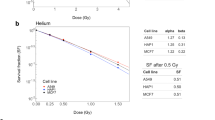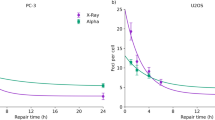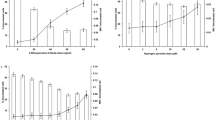Abstract
An understanding of the radiobiological effects of high-linear energy transfer (LET) radiation is essential for radiation protection and human risk assessment. Ever since the discovery of X-rays was made by Röntgen more than a century ago, it has always been accepted that the deleterious effects of ionizing radiation, such as mutation and carcinogenesis, are due mainly to direct damage to DNA. With the availability of a precision single-particle microbeam, it is possible to demonstrate, unequivocally, the presence of a bystander effect with many biological end points. These studies provide clear evidence that irradiated cells can induce a bystander mutagenic response in neighboring cells not directly traversed by α-particles, and that cell–cell communication processes play a critical role in mediating the bystander phenomenon. Following exposure to high-LET radiation, immortalized human bronchial (BEP2D) and breast (MCF-10F) cells have been shown to undergo malignant transformation through a series of successive steps, before becoming tumorigenic in nude mice. There is a progressive increase in genomic instability, determined either by gene amplification or allelic imbalance, with the highest incidence observed among established tumor cell lines, relative to transformed, nontumorigenic and control cell lines.
This is a preview of subscription content, access via your institution
Access options
Subscribe to this journal
Receive 50 print issues and online access
$259.00 per year
only $5.18 per issue
Buy this article
- Purchase on Springer Link
- Instant access to full article PDF
Prices may be subject to local taxes which are calculated during checkout












Similar content being viewed by others
References
Armitage P and Doll R . (1954). Br. J. Cancer, 8, 1–12.
Azzam EI, deToledo SM, Gooding T and Little JB . (1998). Radiat. Res., 150, 497–504.
Calaf G and Hei TK . (2000). Carcinogenesis, 15, 769–776.
Cheng TL, Wei SL, Chen BM, Chern JW, Wu MF, Liu PW and Roffler SR . (1999). Br. J. Cancer, 79, 1378–1385.
Cohen BL . (2002). Am. J. Roentgenol., 179, 1137–1143.
Dale WM . (1940). Biochem. J., 34, 1367–1373.
Dale WM . (1942). Biochem. J., 36, 80–85.
Dale WM . (1943). Br. J. Radiol., 16, 171–172.
Fearon ER and Vogelstein BA . (1990). Cell, 61, 759–767.
Feinendegen LE, Bond VP and Sondhaus CA . (1998). Phys. Soc., 27, 4–6.
Hall EJ . (2000). Radiation Biology for the Radiologist. Lippincott Williams & Wilkins: Philadelphia.
Hei TK, Piao CQ, Han E, Sutter T and Willey JC . (1996a). Radiat. Oncol. Invest., 3, 398–403.
Hei TK, Piao CQ, Sutter T, Willey JC and Suzuki K . (1996b). Adv. Space Res., 18, 137–148.
Hei TK, Piao CQ, Willey JC, Thomas S and Hall EJ . (1994). Carcinogenesis, 15, 431–435.
Hei TK, Wu LJ, Liu SX, Vannais D, Waldren CA and Randers-Pehrson G . (1997). Proc. Natl. Acad. Sci. USA, 94, 3765–3770.
Hei TK, Zhao YL, Roy D, Piao CQ, Calaf G and Hall EJ . (2001). Adv. Space Res., 27, 411–419.
International Commission on Radiological Protection. (1991). ICRP Report 60. Pergamon Press: New York.
Kotval JP and Gray LH . (1947). J. Genet., 48, 135–154.
Lea DE, Smith KM, Holmes B and Markham R . (1944). Parasitology, 36, 110–118.
Loeb LA . (1991). Cancer Res., 51, 3075–3081.
Loeb LA, Loeb KR and Anderson JP . (2003). Proc. Natl. Acad. Sci. USA, 100, 776–781.
Lorimore SA and Wright EG . (2003). Int. J. Radiat. Biol., 79, 15–25.
Mitchell SA, Brenner DB, Zhan F, Randers-Pehrson G and Hall EJ . (2003). Presented at the Microbeam Probes of Cellular Radiation Responses. St. Catherine's College, Oxford.
Morgan WF . (2003). Radiat. Res., 159, 567–580.
Nagar S, Smith LE and Morgan WF . (2003). Cancer Res., 63, 324–328.
Nagasawa H, Huo L and Little JB . (2003). Int. J. Radiat. Biol., 79, 35–41.
Nagasawa H and Little JB . (1992). Cancer Res., 52, 6394–6396.
Nagasawa H and Little JB . (2002). Mutat. Res., 508, 121–129.
National Council on Radiation Protection. (1993). NCRP Report 116. NCRP: Bethesda.
Piao CQ and Hei TK . (2001). Radiat. Res., 155, 263–267.
Piao CQ, Willey JC and Hei TK . (1999). Carcinogenesis, 20, 1529–1533.
Prise KM, Belyakov OV, Folkard M and Mitchell BD . (1998). Int. J. Radiat. Biol., 74, 793–798.
Prise KM, Folkard M, Malcolmson AM, Pullar CH, Schettino G, Bowey AG and Michael BD . (2002). Adv. Space Res., 30, 871–876.
Randers-Pehrson G, Geard CR, Johnson CD, Elliston CD and Brenner DJ . (2001). Radiat. Res., 156, 210–214.
Roy D, Calaf G and Hei TK . (2001a). Mol. Carcinogen., 31, 192–203.
Roy D, Calaf G and Hei TK . (2001b). Carcinogenesis, 22, 1685–1692.
Sawant SG, Randers-Pehrson G, Geard CR, Brenner DJ and Hall EJ . (2001). Radiat. Res., 155, 397–401.
Sawant SG, Zheng W, Hopkins KM, Randers-Pehrson G, Lieberman HB and Hall EJ . (2002). Radiat. Res., 157, 361–364.
Soule HD, Maloney TM, Wolman SR, Peterson WD, Brenz R, McGrath CM, Russo J, Pauley RJ, Jones R and Brooks SC . (1990). Cancer Res., 50, 6075–6068.
Tlsty TD, Margolin B and Lum K . (1989). Proc. Natl. Acad. Sci. USA, 86, 9441–9445.
Weaver D, Hei TK, Hukka B, McRaven JA and Willey JC . (1997). Carcinogenesis, 18, 1251–1257.
Weaver D, Hei TK, Hukku B, DeMuth JP, Crawford EL, McRaven JA, Girgis S and Willey JC . (2000). Carcinogenesis, 21, 205–211.
Windle BE and Wahl GM . (1992). Mutat. Res., 276, 199–205.
Wright JA, Smith HS, Watt FM, Hancock MC, Hudson DL and Stark GR . (1990). Proc. Natl. Acad. Sci. USA, 87, 1791–1796.
Xu GL, Bestor TH, Bourc'his D, Hsieh CL, Tommerup N, Bugge M, Hulten M, Qu X, Russo JJ and Viegas-Pequignot E . (1999). Nature (Lond.), 402, 187–191.
Zhou H, Randers-Pehrson G, Waldren CA, Vannais D, Hall EJ and Hei TK . (2000). Proc. Natl. Acad. Sci. USA, 97, 2099–2104.
Zhou H, Suzuki M, Randers-Pehrson G, Vannais D, Chen G, Trosko JE, Waldren CA and Hei T . (2001). Proc. Natl. Acad. Sci. USA, 98, 14410–14415.
Acknowledgements
We thank Dr Catherine Mitchell for critical reading of the manuscript. This work was supported by funding from the National Institute of Health grants CA 49062, ES 07890, NIH Resource Center Grant RR 11623, Environmental Center grant ES 10349 and from the US Department of Energy DEFG-ER63441.
Author information
Authors and Affiliations
Corresponding author
Rights and permissions
About this article
Cite this article
Hall, E., Hei, T. Genomic instability and bystander effects induced by high-LET radiation. Oncogene 22, 7034–7042 (2003). https://doi.org/10.1038/sj.onc.1206900
Published:
Issue Date:
DOI: https://doi.org/10.1038/sj.onc.1206900
Keywords
This article is cited by
-
Track and dose-average LET dependence of Gafchromic EBT3 and MD-V3 films exposed to low-energy photons
Scientific Reports (2020)
-
Proton-induced direct and indirect damage of plasmid DNA
Radiation and Environmental Biophysics (2015)
-
Identification of gene-based responses in human blood cells exposed to alpha particle radiation
BMC Medical Genomics (2014)
-
Indirect Effects of Radiation Induce Apoptosis and Neuroinflammation in Neuronal SH-SY5Y Cells
Neurochemical Research (2014)



